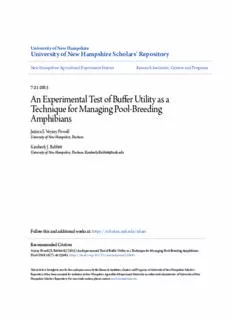Table Of ContentUUnniivveerrssiittyy ooff NNeeww HHaammppsshhiirree
UUnniivveerrssiittyy ooff NNeeww HHaammppsshhiirree SScchhoollaarrss'' RReeppoossiittoorryy
New Hampshire Agricultural Experiment Station
New Hampshire Agricultural Experiment Station
Publications
7-21-2015
AAnn EExxppeerriimmeennttaall TTeesstt ooff BBuuffffeerr UUttiilliittyy aass aa TTeecchhnniiqquuee ffoorr
MMaannaaggiinngg PPooooll--BBrreeeeddiinngg AAmmpphhiibbiiaannss
Jessica S. Veysey Powell
University of New Hampshire, Durham
Kimberly J. Babbitt
University of New Hampshire, Durham, [email protected]
Follow this and additional works at: https://scholars.unh.edu/nhaes
RReeccoommmmeennddeedd CCiittaattiioonn
Veysey Powell JS, Babbitt KJ (2015) An Experimental Test of Buffer Utility as a Technique for Managing
Pool-Breeding Amphibians. PLoS ONE 10(7): e0133642. https://dx.doi.org/10.1371/journal.pone.0133642
This Article is brought to you for free and open access by the New Hampshire Agricultural Experiment Station at
University of New Hampshire Scholars' Repository. It has been accepted for inclusion in New Hampshire
Agricultural Experiment Station Publications by an authorized administrator of University of New Hampshire
Scholars' Repository. For more information, please contact [email protected].
RESEARCHARTICLE
An Experimental Test of Buffer Utility as a
Technique for Managing Pool-Breeding
Amphibians
JessicaS.VeyseyPowell*,KimberlyJ.Babbitt
DepartmentofNaturalResourcesandtheEnvironment,UniversityofNewHampshire,Durham,New
Hampshire,UnitedStatesofAmerica
* [email protected]
a11111
Abstract
Vegetatedbuffersareusedextensivelytomanagewetland-dependentwildlife.Despite
widespreadapplication,bufferutilityhasnotbeenexperimentallyvalidatedformostspe-
OPENACCESS cies.Toaddressthisgap,weconductedasix-year,landscape-scaleexperiment,testing
howbuffersofdifferentwidthsaffectthedemographicstructureoftwoamphibianspeciesat
Citation:VeyseyPowellJS,BabbittKJ(2015)An
ExperimentalTestofBufferUtilityasaTechniquefor 11ephemeralpoolsinaworkingforestofthenortheasternU.S.Werandomlyassigned
ManagingPool-BreedingAmphibians.PLoSONE eachpooltooneofthreetreatments(i.e.,reference,100mbuffer,30mbuffer)andclearcut
10(7):e0133642.doi:10.1371/journal.pone.0133642
tocreatebuffers.Wecapturedallspottedsalamandersandwoodfrogsbreedingineach
Editor:BenediktR.Schmidt,UniversitätZurich, poolandexaminedtheimpactsoftreatmentandhydroperiodonbreeding-populationabun-
SWITZERLAND
dance,sexratio,andrecapturerate.Thenegativeeffectsofclearcuttingtendedtoincrease
Received:February17,2015 asforest-bufferwidthdecreasedandbestrongestforsalamandersandwhenotherstress-
Accepted:June30,2015 orswerepresent(e.g.,atshort-hydroperiodpools).Recapturerateswerereducedinthe
30m,butnot100m,treatment.Throughouttheexperimentforfrogs,andduringthefirstyear
Published:July21,2015
post-cutforsalamanders,thepredictedmeanproportionofrecapturedadultsinthe30m
Copyright:©2015VeyseyPowell,Babbitt.Thisis
treatmentwasonly62%and40%,respectively,ofthatinthereferencetreatment.Frogsex
anopenaccessarticledistributedunderthetermsof
theCreativeCommonsAttributionLicense,which ratioandabundancedidnotdifferacrosstreatments,butsalamandersexratioswere
permitsunrestricteduse,distribution,and increasinglymale-biasedinbothcuttreatments.Bythefinalyear,therewereonaverage,
reproductioninanymedium,providedtheoriginal
onlyabout40%and65%asmanyfemalespredictedinthe100mand30mtreatments,
authorandsourcearecredited.
respectively,comparedtothefirstyear.Breedingsalamandersatshort-hydroperiodpools
DataAvailabilityStatement:Thedatausedinthis
wereabout10%asabundantinthe100mversusreferencetreatment.Ourstudydemon-
studyareavailablefromtheDryaddatabase(doi:10.
stratesthatbufferspartiallymitigatetheimpactsofhabitatdisturbanceonwetland-
5061/dryad.547rp).
dependentamphibians,butbufferwidthandhydroperiodcriticallymediatethatprocess.We
Funding:ThisworkwassupportedbygrantstoKJB
providethefirstexperimentalevidenceshowingthat30-m-widebuffersmaybeinsufficient
fromtheNationalResearchInitiativeoftheUSDA
CooperativeStateResearch,Education,and formaintainingresilientbreedingpopulationsofpool-dependentamphibians,atleastduring
ExtensionService(http://www.csrees.usda.gov/ thefirstsixyearspost-disturbance.
funding/rfas/nri_rfa.html)grantnumbers:2003-35101-
12922and2007-35101-18281;andtheNortheastern
StatesResearchCooperative(http://nsrcforest.org/).
Theprojectwasalsosupportedbyfellowshipsto
JSVPfromtheRobertandPatriciaSwitzer
Foundation(http://www.switzernetwork.org/)the
UniversityofNewHampshireGraduateSchool(http://
PLOSONE|DOI:10.1371/journal.pone.0133642 July21,2015 1/26
AmphibianForestBufferExperiment
www.gradschool.unh.edu/),andtheUniversityofNew Introduction
HampshireCooperativeExtension(http://extension.
Vegetatedbuffershavebeenusedextensivelyforseveraldecadestoprotectwetlandsacrossa
unh.edu/).Partialfundingwasprovidedbyagrantto
KJBfromtheNewHampshireAgricultural varietyoflandscapes.Bufferswereoriginallydesignedtofilterwaterpollutantsandmaintain
ExperimentStation(http://www.colsa.unh.edu/aes). waterquality[1,2].Inthiscontext,15–30m-widebuffersareoftensufficienttoremovenitro-
ThisisScientificContributionnumber:2593.This gen,phosphorus,andsedimentfromrunoffbeforeitenterswetlands[3–5].Overthelasttwo
workwasalsosupportedbytheUSDANational
decadespolicy-makershaveincreasinglyreliedonbufferstoconservewetland-dependentwild-
InstituteofFoodandAgricultureMcIntire-Stennis
life[1–3].Lackingwildlife-specificdata,theyassumed15–30m-widewaterqualitybuffers
Project,accessionnumber:0226124.Thesefunders
hadnoroleinstudydesign,datacollectionand wouldbenefitwildlife[3,6,7].Suchnarrowbuffersmaybeinsufficientformaintainingviable
analysis,decisiontopublish,orpreparationofthe populationsofmanywetland-dependentspecies,however,becausethesespeciesregularlyuse
manuscript. habitatthatextendsfartherfromwetlandsthantypicalwater-qualitybuffers[8–10].
CompetingInterests:Theauthorshavedeclared Thismaybeespeciallytrueforamphibiansthatbreedinephemeralpools.Thesemi-annual
thatnocompetinginterestsexist. dryingcycleofephemeralpoolspreventsestablishmentofpredatoryfishpopulations,making
thesepoolsextremelyproductiveamphibianhabitat.Duringthenon-breedingseason,these
amphibiansrangeacrossthesurroundinglandscape,usingadditionalwetlandsanduplands
forforaging,shelter,estivation,andhibernation[11–13],sometimesmigratinghundredsof
metersintoterrestrialhabitat[14–16].Land-usesthatalterthehabitatqualityofbreeding
poolsand/oradjacentuplandscanpotentiallyhavestrongnegativeeffectsonlocalandregional
populationpersistence.
Historically,ephemeralpoolsreceivedlittlepolicyprotectionintheUnitedStates(U.S.).
FederalprotectionostensiblyfallsundertheCleanWaterAct,butistenuousgivenrecent
SupremeCourtdecisionsandhasneverofficiallyincludedabuffer[17].Somestates,counties,
andmunicipalitiessupplementfederallawbyimplementingmorestringentlocalpolicies.
However,only15of50stateshavesubstantialwetlandprograms,mostofwhichdonotinclude
protection,letalonebuffers,forephemeralpools[18].FourofsixNewEnglandstatesprovide
aregulatorybufferforephemeralpools(mean±SD:23±29m;range:0–76m),butthesebuff-
erstypicallyonlyapplytoasubsetofpoolsandprojecttypes[19–22]andaresubstantiallynar-
rowerthanthe164-290-mbuffersthatscientistsrecommend,basedonamphibianmigration
data(e.g.,[23]).
PreviousobservationalandmodelingstudiesconcludethatregulatorybuffersintheU.S.are
inadequateforprotectingpopulationsofephemeral-pool-breedingamphibians[10,23,24].In
mostofthesestudies,however,buffereffectswereneverexplicitlytested,butratherestimated
fromspecies’migrationdistancesinundisturbedhabitat.Thus,verylittleisactuallyknown
abouthowthedemographicsandbehaviorofephemeral-pool-breedingamphibiansdifferin
unbufferedandbufferedsystems,andwhatoptimalbufferwidthsarefordifferentspecies.
Overall,experimentalconfirmationoftheneedforwiderbuffersisseverelylacking.Though
somepolicy-makersexpressinterestinexpandingbufferstoaccommodatewildlifehabitat
needs[25–27],theyhesitatetosupportpolicychangeswithoutsolid,experimentalevidence
demonstratingtheutilityofbuffersforwildlife[28,29].
Toaddressthisneed,weconductedasix-year,landscape-scaleexperimentandexamined
howbuffersofdifferentwidthsaffectbreeding-adultdemographyfortwoamphibianspeciesat
ephemeralpoolsinanindustrialforestofthenortheasternU.S.Westudiedspottedsalaman-
ders(Ambystomamaculatum)andwoodfrogs(Lithobatessylvaticus)becausetheyusesimilar
macrohabitat,butdifferinmicrohabitatpreferencesandkeydemographictraits,andmaythus
requiredifferentconservationstrategies.Inparticular,spottedsalamandersutilizesmall-
mammalburrowsextensivelyasrefugia[13,30],canliveupto32yearsinthewild(meanadult
ageinonenorthernpopulationwas8.8years;[31,32]),andusuallybreedmultipletimesin
theirlives[33].Bycontrast,woodfrogsseekrefugeinotherwetlandsduringthesummer[11],
overwinterinleaflitter[11,34],haveamaximumlifespanof5–6years[35,36],andtypically
PLOSONE|DOI:10.1371/journal.pone.0133642 July21,2015 2/26
AmphibianForestBufferExperiment
breedonlyonceafterreachingsexualmaturity[35,37],butaremorefecundthanspottedsala-
manders[10].
Foreachspecies,weexaminedwhethertheabundance,proportionrecaptured,andsexratio
ofbreedingadultsdifferedacrossbuffertreatmentsand/orvariedwithtimeasdisturbedforest
aroundexperimentalbuffersregenerated.Wehypothesizedthat:
1. Forbothspecies,breeding-adultabundanceandrecaptureproportionwouldbepositively
correlatedwithbufferwidth.Weexpectthisbecausewiderbuffersprovideagreaterareaof
high-qualityhabitatinproximitytobreedingpoolsandshouldsupportalarger,morestable
breedingpopulationthanpoolswithnarrowerbuffers.
2. Forbothspecies,breeding-adultsexratio(i.e.,theproportionofmalesinthebreedingpop-
ulation)wouldvarywithbufferwidth.Malesofbothspeciesclusterclosertobreedingpools
thandofemales,suchthatgenerally,buffersshouldprovidemorehabitatformales,and
femalesshouldbedisproportionatelyimpactedbydisturbancesbeyondthebuffer[38–40].
Duetoalackoffine-grainresolutioninexistingknowledgeofthespatialdistributionof
bothsexesaroundpools,however,wedidnotpredictdirectionalityintherelationship
betweensexratioandbufferwidth.
3. Forbothspecies,anynegativeimpactstobreeding-adultabundance,recaptureproportion,
orsexratiointhebufferedtreatmentswouldrecoverwithtime(i.e.,berestoredtovalues
similartothoseinthereferencetreatment,afterdeviatingfromreference-treatmentvalues
atsomepriortime),asdisturbedforestsregenerated.
4. Woodfrogs,beingmorefecund,wouldrecoverfasterthanspottedsalamanders.
Methods
Studysite
Weconductedthisresearchinanindustrialforest,privatelyownedbyInternationalPaper/
SustainableForestTechnologies,ineast-centralMaine,U.S.(45°0’52”N,44°48”32”N;68°
28’11”W,67°53’10”W).Theforestispredominantlyeasternhemlock(Tsugacanadensis)and
northernhardwood(Fagusgrandifolia,Acersaccharum,Betulaalleghaniensis)atlowereleva-
tions,andbalsamfir(Abiesbalsamea)andredspruce(Picearubens)athigherelevations.Mod-
eratehills,wetlands(includingnumerousephemeralpools),anddirtloggingroadsare
common.In2002,weidentified300ephemeralpoolsinthislandscapeandchose40ofsimilar
size(i.e.,0.1–0.3ha)andadjacentforest(i.e.,uncutwithin1000m)forin-depthinspection.In
spring2003,wesurveyedeggmassesatthese40poolsandidentified35withbreedingpopula-
tionsofbothwoodfrogsandspottedsalamandersandhydroperiodsofatleastfivemonths
post-iceout.Werandomlychose12ofthe35poolsforthisstudy.Inspring2004,welearned
thatoneofthe12poolshadapermanentinflowandremovedthatpoolfromthestudy.
Buffercreation
Werandomlyassignedeachoftheremaining11poolstooneofthreetreatments:reference
(i.e.,uncut;N=3),100mbuffer(N=4),or30mbuffer(N=4).FromSeptember2003to
March2004,thelandownerusedclearcuttingtocreateexperimentalbuffersatthe100mand
30mtreatmentpools.Thecuttingremovedallmerchantabletrees(cid:1)5cmdiameteratbreast
heightandslash,thoughasmallquantityofwoodydebrisremained.Aftercutting,poolsinthe
twobuffertreatmentshad,respectively,a100-mor30-m-wideuplandbufferencirclingthe
poolanda100-m-wideconcentricclearcutaroundthebuffer(Fig1).Weselectedbufferwidths
PLOSONE|DOI:10.1371/journal.pone.0133642 July21,2015 3/26
AmphibianForestBufferExperiment
Fig1.Experimentaldesignimplementedat11naturalephemeralpoolsineast-centralMaine,USA.Undisturbedbuffersofeither100m(left;n=4)or
30m(right;n=4)wereleftadjacenttopoolsand100-m-wideclearcutswerecreatedaroundthebuffers.Forestbeyondtheclearcutwasundisturbed.No
cuttingoccurredatreferencepools(notshown;n=3).
doi:10.1371/journal.pone.0133642.g001
typicalofthoseinexistinglaws,BestManagementPractices(i.e.,voluntaryforestryanddevel-
opmentpoliciesdesignedtoprotectwaterandsoilquality),andtheliterature(e.g.,[12,41,
42]).
Amphibiansampling
Duringsummerandfall2003,weencircledeachofthe11poolswithadriftfence/pitfalltrap
array[43].Weusedplasticsiltfencingthatwas91cmtallandburied8–10cmdeepandposi-
tionedfences5mupgradientofeachpool’shighwatermarktominimizefloodingrisk.We
buriedpairsof5.7literaluminumcansonoppositesidesofthedriftfenceat10mintervals
[43].Topreventamphibiandesiccation,weplacedamoistenedspongeinthebottomofeach
trap.
From2004through2009,weopenedtrapsinthespringafterice-outandclosedtrapswhen
apoolwasdryforatleastsevenconsecutivedaysor,inthefall,whenamphibianswerenolon-
geractiveduetohardfrosts.Weuprootedsectionsofthefenceduringthewintertoallow
movementofnon-focalspecies.Wecheckedpitfalltrapsdailyduringperiodsofhighamphib-
ianactivity(i.e.,April-MayandJuly-September)andeveryonetofivedaysduringperiodsof
lessamphibianactivity(i.e.,Juneandlatefall).Duetopoorroadconditions,wecouldnot
accessone30m-bufferpoolin2009.However,ourstatisticaltechniquewasrobusttomissing
data[44],allowingustousetheotherfiveyearsofdatafromthispool.
Wecapturedandcountedallamphibiansenteringandexitingthepoolsandsexedalladult
amphibiansexitingpools.Weassumedallnon-gravidadultspottedsalamandersandwood
frogsleavingapoolhadbredinthatpoolandmarkedeachwithapool-specifictoe-clip[45].
PLOSONE|DOI:10.1371/journal.pone.0133642 July21,2015 4/26
AmphibianForestBufferExperiment
Afterprocessingeachanimal,wereleaseditontheoppositesideofthefencefromthepointof
capture.From2005to2009,wecountedthenumberofrecapturedindividualsateachpool.A
pool-specifictoe-clipwasnecessarybecausesomepoolswereincloseenoughproximitythat
inter-pooldispersalwaspossible.However,giventhestudy’sdurationandtheproblemsassoci-
atedwithcuttingmultipletoes[46–48],wedidnotmarkanimalsseparatelyforeachyearthey
werecapturedoreventoindicatetheinitialcaptureyear.Itisthuspossiblethatafewanimals
werecountedmorethanonceinasingleyear.Tominimizethechanceofthisoccurring,we
tookthefollowingprecautions.First,ifanindividualreturnedtoapoolinthesameyearthatit
wasfirstmarked(indicatedbyafreshtoecut),weonlyincludeditsinitialvisitforthatyearin
ouranalyses.Second,weonlycountedandmarkednon-gravidfemales.Similarly,though
closeddrift-fencearraysarehighlyefficientattrappingadultambystomatidsandwoodfrogs
[40,49,50],itispossiblethatsomeindividualstrespassed(i.e.,climbedoverorunder)the
fenceandwereundetectedbyourcounts.Tolimitpotentialtrespass,weregularlyinspected
andmaintainedourfences.Weneversawadultwoodfrogsorspottedsalamandersclimbing
fencesduringinspections.Iftrespassdidoccur,ouramphibiancountswouldbeconservative.
Bycontrast,anymultiplecountsofthesameindividualinagivenyearwouldsomewhatinflate
ourrecapturecounts.Overall,however,thenumbersofanimalsthattrespassedorwere
countedmorethanonceinayearwouldbeverysmallcomparedtothetotalnumberof
amphibianstrapped.Furthermore,wehavenoreasontoexpectthatmultiple-countortrespass
rateswoulddifferacrosstreatmentsoryears.Consequently,ouranalysesshouldremainvalid,
despiteanymultiplecountsortrespass.
Hydroperiodsampling
Wecalculatedhydroperiodforeachpoolineachyearasthenumberofdaysapoolheldwater
betweenice-out(i.e.,<75%ofthepoolwascoveredinice)andthedaythepooldried
completely.Tofacilitatestatisticalanalyses,weassignedahydroperiodenddateofOctober
28thtopoolsthatdidnotdryinagivenyear.Wechosethisenddatebecausewestillhadevi-
denceofpersistentwaterinthesepoolsonthisdate,butitwassufficientlylateintheyearthat
mostamphibiansatourstudypoolswereinactive.
Statisticalanalyses
Toassesstherelativeimpactsofforestrytreatmentandhydroperiodonthesizeandcomposi-
tionofspottedsalamanderandwoodfrogactive-breedingpopulations,wedevelopedgeneral-
izedlinearmixedeffectsregressionmodelsusingthe“glme”functioninthecorrelatedData
libraryofS-Plus8.0(InsightfulCorporation,Seattle,WA,USA2007)andthe“glmer”function
inthelme4library[51]ofR2.13.0[52].Wedefinetheactive-breedingpopulationasalladults
thatmigratetoapoolandattempttobreedinagivenyear.Thus,ourresultsapplytoasubset
ofeachspecies’totallocalpopulationanddonotaccountforadultsalamandersthatskip
breedinginagivenyearorjuveniles.Fortherestofthispaper,werefertoourstudypopulation
simplyas“breedingadults.”
Wemodeledboththesexratioandproportionofrecapturedadultsforeachspeciesusing
mixed-effectslogisticregressionwithalogitlink.Wedefinedsexratio,withineachstudyyear
andatagivenpool,as:Numberofbreedingmales/(Numberofbreedingmales+Numberof
breedingfemales).Wedefinedtheproportionofrecapturedadults,withineachstudyyearand
atagivenpool,as:Numberofrecapturedbreedingadults/(Numberofrecapturedbreeding
adults+Numberofnew-capturedbreedingadults).Notethatthenumberofrecapturedbreed-
ingadultsinagivenyearissimplyacountofthenumberofmarkedindividualsthatreturned
tobreedataparticularwetlandinthegivenyear,withoutdistinguishingbetweenadults
PLOSONE|DOI:10.1371/journal.pone.0133642 July21,2015 5/26
AmphibianForestBufferExperiment
markedindifferentyears.Thisdefinitionofrecapturedadultsderivesfromourmethodof
markingindividualswithapool-specifictoe-clip,butnotayear-specifictoe-clip.Wemodeled
breeding-adultabundanceforeachspecieswithmixed-effectsPoissonregression,usingalog
link.Wedefinedbreeding-adultabundanceasthetotalnumberofadults(i.e.,recaptured
adults+new-capturedadults)activelybreedinginagivenyearatagivenpool.
WetreatedyearandpoolIDascrossedrandomeffects[44]inallmodels.Wemodeledthe
variance-covariancestructureforeachregressiontoaccountforinter-yearcorrelationatindi-
vidualpoolsandheterogeneousvarianceacrossgroups.Weusedlikelihoodratioteststoopti-
mizeeachregression’svariance-covariancestructure.Weaccountedforintra-poolcorrelation
inthesalamanderabundancemodelusingafirst-orderauto-regressiveprocesswithyearasthe
timevariable.Wedidnotneedtodefineacorrelationstructureforanyothermodel.Wespeci-
fiedthevariancestructureforallmodelsexcepttheproportion-of-recaptured-salamander
model.Forsalamandersexratio,weassigneddifferentvariancestoeachstudyyear.Forsala-
manderabundance,weallowedthevariancetoincreaseexponentiallyasafunctionofmean-
poolhydroperiod(i.e.,themeanhydroperiodforeachpoolacrossthesixstudyyears).Forthe
proportion-of-recaptured-frogsmodel,weassigneddifferentvariancestoeachtreatment.For
frogsexratio,weallowedthevariancetoincrease,withineachstudyyearseparately,asapower
functionofthemodel’sfittedvalues.Forfrogabundance,weallowedthevariancetoincrease,
withineachtreatmentseparately,asapowerfunctionofthestandarddeviationofpoolhydro-
period(ascalculatedforeachpoolacrossthesixstudyyears).Intheirfinalforms,allmodels
satisfiedtheassumptionsofPoissonorlogisticregression.
Ourpredictorvariableswere:buffertreatment,mean-poolhydroperiod,standarddeviation
ofpoolhydroperiod,aninteractionbetweentreatmentandmean-poolhydroperiod,andapair
ofnumericdummyvariablesrepresentinganinteractionbetweentreatmentandstudyyear.
Weusedthefirstdummyvariable(dv.cut)todistinguishwhetherapoolwassubjectedtoclear-
cuttingornot.Weusedtheseconddummyvariable(dv.30m)toindicatemarginalimpactsto
the30mtreatmentpools.Weuseddummyvariablestorepresenttheeffectsofstudyyearfor
severalreasons.First,weneededtocapturepotentialchangesovertimeastheclearcutsregen-
erated.Second,wecouldnottreatyearasacategoricalvariableasthisrequiredestimatingfive
coefficientsforyearaloneandourmodelswouldnotconvergewiththisformulation.Whenwe
usedthetwodummyvariables,bycontrast,weonlyneededtoestimatetwocoefficients,we
couldsimultaneouslyinvestigateatreatmentXyearinteraction,andourmodelsconverged.
Becauseofthisformulation,however,wecouldnottestforsignificantdifferencesbetweenspe-
cificyears.Rather,weusedtheestimateddummy-variablecoefficientstodescribedifferences
intheaverageratesofchangeovertimeacrosstreatments.WeusedANOVAstodeterminethe
overallsignificanceofeachfixedeffectandt/ztests(forS-plusandRmodels,respectively)to
testthesignificanceofthedifferenttreatmentlevels(α=0.05).Weusedtreatmentcontraststo
comparethereferencetreatmenttoeachrespectivecuttreatment(i.e.,bydefault,therewasno
directcomparisonbetweenthe100mand30mtreatments;[44]).WeappliedasequentialBon-
ferroniproceduretoadjustα-levelsduringaposthoccomparisonbetweenthe100mand30m
treatmentsfortheproportion-of-recaptured-frogsmodel(i.e.,theonlymodelwithasignificant
overalltreatmenteffect,butnosignificantdifferencesidentifiedbythedefaultinter-treatment
comparisons).
Basedonourexperimentaldesign;priorknowledgethathydroperiodstronglyinfluences
bothspecies’populationdynamics;andadesiretoapproximatenaturalconditions,whereall
predictorssimultaneouslyactonthespecies’populations,wedecidedaprioritoretainallpre-
dictorsineachmodel,whetherornottheywerestatisticallysignificant.Weallowedtwoexcep-
tionstothisrule.First,basedonanaprioridecision,wedroppedthehydroperiodinteraction
fromamodelwhenitwasnotsignificantandrefitthemodelfortheremainingfixedeffects.
PLOSONE|DOI:10.1371/journal.pone.0133642 July21,2015 6/26
AmphibianForestBufferExperiment
Wemadethisdecisionprincipallybecause,unlikefortheotherpredictors,wehadnostrong
priorreasontothinktheremustbeatreatmentXhydroperiodinteraction.Ultimately,weonly
includedthehydroperiodinteractioninthesalamander-abundancemodel.Second,we
droppeddv.30mfromtheproportion-of-recaptured-frogsmodelbecausedv.30mandtreat-
mentwereconfounded,withbothpredictorseffectivelycancelingeachotherout.Forthis
modelalone,weinvestigatedthepossibilityofconfoundingfactorsbecauseraw-datagraphs
suggestedaverystrong30m-treatmenteffect,whichwasnotsupportedbythefullmodel
results.Wetestedforconfoundingfactorsbysystematicallydroppingeachpredictorinturn
fromthemodelandassessingmodelfit(usinggraphsoffittedversusobservedvalues).Ulti-
mately,weretainedtreatmentinsteadofdv.30mbecauseareducedmodelwithtreatmentpro-
videdabetterfitthanonewithdv.30m.However,thereduceddv.30mmodelsuggestedthat
theproportionofrecapturedfrogsinthe30mtreatmentdecreasedduringthestudy.Wedid
nottestforconfoundingfactorswiththeothermodels,aswehadnoevidencetosuggestthat
thismightbeaproblemforanyothermodel.
Ethicsanddatadepositionstatements
WeconductedalloftheresearchinaccordancewiththerulesoftheInstitutionalAnimalCare
andUseCommitteeattheUniversityofNewHampshire(IACUC-UNH).IACUC-UNH
approvedourresearchprotocol,asdetailedinpermits:020601and050604.Noneofthecap-
turedspecieswereprotectedorendangeredunderfederalorstatelaw.Weconductedthe
researchonprivateland,withpermissionfromthelandowner.Forthesereasons,noadditional
permitsorpermissionwereneededtoconductthiswork.Thedatausedinthisstudyareavail-
ablefromtheDryaddatabase(DOI:10.5061/dryad.547rp).
Results
From2004to2009,wecaptured3624breedingspottedsalamanders,including2811(78%)
new-capturesand812(22%)recaptures,and1518(42%)femalesand2099(58%)males.Simi-
larly,wecaught6521breedingwoodfrogs,including5478(84%)new-captures,1014(16%)
recaptures,2427(37%)females,and4072(63%)males.Breeding-adultabundance,especially
forwoodfrogs,washighlyvariablewithinandacrosspoolsandyears(Table1,Fig2).For
example,atonereferencepool,annualbreedingwoodfrogabundancerangedfrom70to568,
withameanof214frogs,whileatadifferentreferencepool,breedingwoodfrogabundance
rangedfrom54to161,withameanof95.Hydroperiodalsovariedwidelyinthisforest-
ephemeralpoolecosystem.Onesemi-permanentpoolnevercompletelydriedduringthesix-
yearstudy.Bycontrast,meanhydroperiodatanotherpoolwasaboutfourmonths,butvaried
byasmuchas49days.
Spottedsalamanders
Breeding-salamandersexratioincreasedsignificantlyinbothcuttreatmentsduringthestudy,
andamarginallysignificanttrendindicatedthattherateofincreaseinthe30mtreatmentwas
slightlylowerthanthatinthe100mtreatment(Table2;Fig3).Forexample,at100m-buffer
pools,wepredictedapproximatelyequalnumbersofeachsexin2004,but2.3malesperfemale
in2009.Similarlyat30m-bufferpools,wepredictedapproximately1.3malesperfemalein
2004,but2malesperfemalein2009.Atreferencepools,bycomparison,wepredicted1.1
malesperfemale,onaverage.Inbothcuttreatments,themale-biasedsexratioswereprinci-
pallydrivenbyadecreaseinthenumberofbreedingfemales.
Theproportionofrecapturedbreedingsalamanderswassignificantlylowerinthe30mver-
susreferencetreatmentrightafterthecut,butsignificantlyincreasedwithtime,sothatby2008
PLOSONE|DOI:10.1371/journal.pone.0133642 July21,2015 7/26
AmphibianForestBufferExperiment
Table1. Meanandvariabilityofpredictorandoutcomevariablesat11naturalephemeralpoolsineast-centralMaine,USA. Populationparameters
representactivelybreedingadultsonly.
Mean±SE Range
Meanhydroperiod(days) 125.96±5.98 44.83–197.00d
SDhydroperiod(days)a 31.81±1.58 6.32–48.76
SpottedSalamander WoodFrog
Mean±SE Range Mean±SE Range
Abundance
Reference 36.44±3.95 10–66 135.61±27.58 54–568
100m 76.29±16.46 0–242 88.21±13.35 7–215
30m 49.52±7.96 9–157 86.35±11.18 14–221
Proportionrecapturedb
Reference 0.31±0.04 0.06–0.51 0.23±0.04 0.05–0.67
100m 0.23±0.04 0.00–0.63 0.19±0.03 0.03–0.42
30m 0.19±0.03 0.00–0.48 0.09±0.01 0.00–0.18
Sexratioc
Reference 0.55±0.04 0.10–0.78 0.62±0.04 0.31–0.88
100m 0.59±0.04 0.17–1.00 0.60±0.03 0.14–0.76
30m 0.58±0.03 0.38–0.81 0.62±0.03 0.32–0.86
aStandarddeviationofthepoolhydroperiod.
bProportionrecaptured=numberofrecapturedbreedingadults/(numberofrecapturedbreedingadults+numberofnew-capturedbreedingadults).
cSexratio=numberofbreedingmales/(numberofbreedingmales+numberofbreedingfemales).
dSomepoolsdidnotdryinsomeyears.Tofacilitateanalyses,weassignedsuchpoolsalate-fallhydroperiodenddate.Meanhydroperiodwascalculated
usingthecappedenddates.
doi:10.1371/journal.pone.0133642.t001
(i.e.,fiveyearspost-cut),recaptureproportionsat30m-bufferpoolswerepredictedtobeonly
slightlylessthanthoseatreferencepools(Fig4).Thesetrendswerelargelydrivenbymaleand
femalenew-captureabundance,whichtendedtobehigherinthe30mtreatmentduringthe
firstthreeyearsofthestudy,butsimilarinthetwotreatmentsbythestudy’send.Toalesser
extent,thesetrendsmayalsobeexplainedbyrecapturenumbersinthe30mtreatment,which
werelowimmediatelyafterthecut(butalsoduringthelasttwostudyyears.Infact,werecap-
turednofemalesfromthe30mtreatmentin2009.However,fewsalamanderswererecaptured
inanytreatmentin2009andwecouldonlytrapatthreeofthefour30m-bufferpoolsin2009).
Therewasnosignificantdifferenceintheproportionofrecapturedsalamandersbetweenthe
referenceand100mtreatments.
Atshorthydroperiodpools,wefoundsignificantlyfewerbreedingspottedsalamandersin
the100mtreatmentthanthereferencetreatment(Fig5).Forinstance,ifpoolmeanhydroper-
iodwere45days(theminimummeanhydroperiodobserved),thenumberofbreedingsala-
mandersata100m-bufferpoolwaspredictedtobeonlyabout12%oftheabundanceata
referencepool.However,abundanceincreasedsignificantlywithmeanhydroperiodatthe
100m-bufferpools,suchthatforeachadditionaldayapoolheldwater,thenumberofbreeding
adultswaspredictedtoincreasebyabout3%.Wefoundnosignificantdifferenceinbreeding
salamanderabundancebetweenthereferenceand30mtreatments.
Woodfrogs
Thoughwefoundnodifferenceinrecaptureproportionbetweenthereferenceandeithercut
treatment,thesignificantresultsofthepost-hoctestshowedthattheproportionofrecaptured
breedingadultsinthe30mtreatmentwaspredictedtobe,onaverageandforthedurationof
PLOSONE|DOI:10.1371/journal.pone.0133642 July21,2015 8/26
AmphibianForestBufferExperiment
Fig2.Breedingspottedsalamanderandwoodfrogabundance.Shownforpopulationsat11naturalephemeralpoolsineast-centralMaine,USA,across
thesixstudyyears.Eachpoolislabeledwithanidentifyingnumberandtheappliedforestrytreatment.Experimentalforestrytreatmentswere:reference
(uncut),100mundisturbedbuffer,30mundisturbedbuffer.
doi:10.1371/journal.pone.0133642.g002
thestudy,62%ofthatinthe100mtreatment(Fig6).Thiswaslargelybecausebothmaleand
femalerecaptureswerescarceinthe30mtreatment.Infact,nofemaleswererecapturedat
30m-bufferpoolsin2008.Buffertreatmentwasnotasignificantpredictorofbreedingwood
frogabundanceorsexratio,butwedidfindsignificantlymorebreedingwoodfrogsatpools
withlongerhydroperiods.Foreachadditionaldayapoolheldwater,abundancewaspredicted
toincreasebyafactorof0.7%.
Discussion
Thisisthefirstlandscape-scaleexperimenttoexplicitlytestwhethervegetatedbuffersarean
effectivetoolformanagingephemeral-pool-breedingamphibiansandtocomparethevariable
impactsofdifferentbufferwidthsonbreeding-amphibiandemography.Wefoundbuffer
width,timesincecut,andpoolhydroperiodwereallimportantfactorsindeterminingbreed-
ing-adultresponsetoclearcuttingofterrestrialhabitataroundephemeralpools.Contraryto
ourhypotheses,breeding-populationabundanceandbufferwidthwerenotpositively
PLOSONE|DOI:10.1371/journal.pone.0133642 July21,2015 9/26
Description:Veysey Powell JS, Babbitt KJ (2015) An Experimental Test of Buffer Utility .. However, our statistical technique was robust to missing Experimental design implemented at 11 natural ephemeral pools in . example, at one reference pool, annual breeding wood frog abundance ranged from 70 to 568,.

